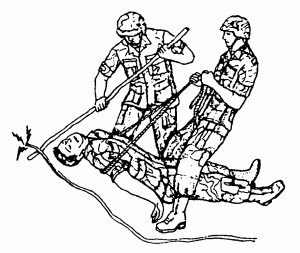If the casualty is still in contact with the source of the electrical current, such as lying on a “live” electrical wire, separate the casualty from the source of the current.
Assume that any electrical wire is alive (carrying electrical current) and is a danger to you as well as to the casualty.
a. Stop the Current, if Practical.
If the electrical current can be turned off quickly, such as flipping a nearby switch, turn off the current first. If it will take more time to turn off the current than to separate the casualty from the electrical wire, cut off the electrical current after you have removed the casualty from the current and have treated the casualty.
CAUTION: Assume the electrical wire is still carrying electrical current even though you think you turned off the current. Do not touch the electrical wire or the casualty as long as he is in contact with the wire. Electrical current can pass from the wire through the casualty to you.
b. Separate Casualty and Current.
You must separate the casualty from the current before beginning your evaluation of the casualty. Either remove the wire from the casualty or remove the casualty from the wire. If rubber gloves are readily available, put them on before moving the wire or casualty.
(1) Move the wire away from the casualty. Stand on a dry surface. Loop a dry rope, dry clothing, or other material which will not readily conduct electricity under the casualty’s body and lift the casualty from the wire. Have a second person use a wooden limb or similar nonconductor to move the wire away from the casualty (figure 6-7). Gently lower the casualty to the ground after the wire has been removed.

(2) Move the casualty away from the wire. If you cannot remove the wire from the casualty (no other soldier available to assist, for example), remove the casualty from the wire. Loop material that will not readily conduct electricity, such as a dry rope, around the casualty’s limb and drag the casualty away from the wire. Do not let your body come into contact with the casualty or the wire during the process.
